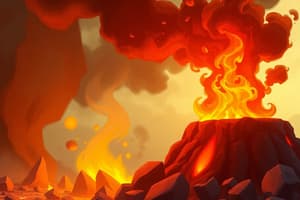Podcast
Questions and Answers
What does the law of conservation of energy state?
What does the law of conservation of energy state?
- Energy is always present in a usable form.
- Energy can only be transformed from one form to another. (correct)
- Energy can be created or destroyed.
- Energy can be consumed in large quantities.
What are fuels primarily used for?
What are fuels primarily used for?
- Absorbing energy from the environment.
- Converting energy directly into work.
- Generating heat for domestic and industrial purposes. (correct)
- Generating electric current.
How are chemical fuels categorized?
How are chemical fuels categorized?
- By their atomic mass and reactivity.
- By their historical importance and usage.
- By their efficiency and storage capability.
- By their physical states and natural occurrence. (correct)
What occurs during the combustion of fuels?
What occurs during the combustion of fuels?
Which process releases energy through the rearrangement of valence electrons?
Which process releases energy through the rearrangement of valence electrons?
What is the main characteristic of nuclear fuels?
What is the main characteristic of nuclear fuels?
What byproducts are formed during the combustion of carbon-based fuels?
What byproducts are formed during the combustion of carbon-based fuels?
Which of the following statements about energy is true?
Which of the following statements about energy is true?
What is a characteristic of primary fuels?
What is a characteristic of primary fuels?
Which of the following is an example of a secondary fuel?
Which of the following is an example of a secondary fuel?
What type of fuel is derived from crude oil?
What type of fuel is derived from crude oil?
Which characteristic is NOT typically associated with good chemical fuels?
Which characteristic is NOT typically associated with good chemical fuels?
Which of the following is a solid fuel?
Which of the following is a solid fuel?
What is the primary purpose of using chemical fuels?
What is the primary purpose of using chemical fuels?
Which of the following describes gaseous fuels?
Which of the following describes gaseous fuels?
What can be considered a non-renewable primary fuel?
What can be considered a non-renewable primary fuel?
What is the primary component of natural gas?
What is the primary component of natural gas?
Which process is primarily used to separate crude oil into different liquid fuels?
Which process is primarily used to separate crude oil into different liquid fuels?
Which fuel is derived from the breakdown of organic matter in the absence of oxygen?
Which fuel is derived from the breakdown of organic matter in the absence of oxygen?
What does proximate analysis measure in fuels such as coal?
What does proximate analysis measure in fuels such as coal?
Which type of alcohol is NOT typically included in the category of alcohol fuels?
Which type of alcohol is NOT typically included in the category of alcohol fuels?
Which of the following is a feature of odorisers added to gaseous fuels?
Which of the following is a feature of odorisers added to gaseous fuels?
What does heating value analysis determine in fuels?
What does heating value analysis determine in fuels?
Which liquid fuel is produced from distilled petroleum and widely used for transportation?
Which liquid fuel is produced from distilled petroleum and widely used for transportation?
What is the method used to measure the heating values of fuels?
What is the method used to measure the heating values of fuels?
What defines the Higher Heating Value (HHV) of a fuel?
What defines the Higher Heating Value (HHV) of a fuel?
Which statement reflects the relationship between HHV and LHV?
Which statement reflects the relationship between HHV and LHV?
How is the Lower Heating Value (LHV) of fuel determined?
How is the Lower Heating Value (LHV) of fuel determined?
What is the significance of water being present in the flue gases during heating value analysis?
What is the significance of water being present in the flue gases during heating value analysis?
What is the heating temperature range for determining volatile matter in fuel samples?
What is the heating temperature range for determining volatile matter in fuel samples?
How is the percentage of fixed carbon calculated?
How is the percentage of fixed carbon calculated?
What compounds do carbon and hydrogen in a fuel sample convert into during ultimate analysis?
What compounds do carbon and hydrogen in a fuel sample convert into during ultimate analysis?
What equipment is typically used to estimate nitrogen content in a fuel sample?
What equipment is typically used to estimate nitrogen content in a fuel sample?
Which substances primarily constitute ash after fuel combustion?
Which substances primarily constitute ash after fuel combustion?
How long should the residue be heated to determine the ash content in fuel?
How long should the residue be heated to determine the ash content in fuel?
During the combustion process for ultimate analysis, which material absorbs carbon dioxide?
During the combustion process for ultimate analysis, which material absorbs carbon dioxide?
What is the process of determining the composition of fuels called?
What is the process of determining the composition of fuels called?
Flashcards are hidden until you start studying
Study Notes
Sources of Energy
- Energy can be transformed but never created or destroyed.
- Sources of energy are resources that can be converted into useful forms of energy.
- Energy not used for work is stored as potential energy or released as heat into the surrounding environment.
Types of Energy Sources
- Fuels: combustible substances releasing heat during combustion
- Chemical Fuels: React with other substances to release energy through combustion.
- Classified by physical properties like solid, liquid, or gas.
- Classified by occurrence as primary or secondary fuels.
- Nuclear Fuels: Substances releasing nuclear energy through fission or fusion
- Chemical Fuels: React with other substances to release energy through combustion.
Combustion of Fuels
- During combustion, carbon, hydrogen, etc., combine with oxygen, releasing heat rapidly.
- This energy release is due to electron rearrangement of valence electrons.
- The formation of compounds like CO2 and H2O releases energy, making them less energetic than the reactants.
Classification of Chemical Fuels
- Based on Occurrence:
- Primary Fuels: naturally occurring, can be extracted, cleaned, or graded with minimal energy conversion.
- Include renewable resources like biomass, geothermal, hydroelectric, wind, and solar.
- Include non-renewable resources like fossil fuels, including coal, crude oil, and natural gas.
- Secondary Fuels: Derived from primary fuels by further processing.
- Examples: coke, charcoal, kerosene, coal gas, producer gas, etc.
- Primary Fuels: naturally occurring, can be extracted, cleaned, or graded with minimal energy conversion.
- Based on Physical State:
- Solid Fuels: wood, peat, lignite
- Liquid Fuels: crude oil, tar, diesel, petrol, kerosene
- Gaseous Fuels: natural gas, coal gas
Characteristics of Good Chemical Fuels
- Suitability: Match the intended purpose.
- High Calorific Value: Produces significant heat per unit mass or volume.
- Ignition Temperature: Easily ignited for efficient combustion.
- Low Moisture Content: Reduces the amount of heat needed to evaporate water.
- Low Non-Combustible Matter Content: Minimizes ash and reduces efficiency loss.
- Controlled Combustion Velocity: Ensures safe and sustainable combustion.
- Desirable Combustion Products: Produces minimal pollution or harmful byproducts.
- Cost-Effective: Affordable for practical use.
- Low Smoke Production: Reduces environmental impact and health risks.
- Controllable Combustion Process: Allows for adjustments in heat output and efficiency.
Solid Chemical Fuels
- Wood: Firewood, charcoal, woodchips, pellets, sawdust
- Charcoal: Produced by heating wood without oxygen.
- Biomass: Natural plant materials like wheat straw and fibrous materials.
- Peat: Decayed vegetation that can be burned when dry.
- Coal: Formed from dead plants over millions of years.
- Coke: High carbon content material derived from coal.
- Waste: Various types of waste (excluding toxic materials) that can be burned.
Liquid Chemical Fuels
- Primarily used for generating mechanical energy from combustion gases.
- Majority are fossil fuels.
- Petroleum: Most common liquid fuel formed from dead plants and animals.
- Gasoline/Petrol: Produced by refining crude oil and distillation.
- Diesel: Mixture of aliphatic hydrocarbons extracted from petroleum and processed for sulfur removal.
- Kerosene: Extracted from petroleum.
- Liquefied Petroleum Gas (LPG): Mixture of propane and butane compressed at high pressure.
- Biodiesel: Diesel fuel based on vegetable oils or animal fat.
- Alcohols: Methanol, ethanol, butanol.
- Liquefied Hydrogen: Used as liquid rocket fuel.
Fractional Distillation
- A method for separating components of crude oil based on their boiling points.
Gaseous Chemical Fuels
- Distributed through pipelines or liquefied for storage.
- Often have odorizers added for safety detection.
- Natural Gas: Mainly composed of methane.
- Coal Gas: Derived from coal.
- Water Gas: Mixture of carbon monoxide and hydrogen.
- Syngas: Synthetic gas consisting of hydrogen, carbon monoxide, and carbon dioxide.
- Biogas: Mixture of gases from organic matter decomposing without oxygen.
- Blast Furnace Gas: Byproduct of iron production in blast furnaces.
Analysis of Fuels
- Used to assess the quality of fuels.
- Includes proximate analysis, ultimate analysis, and heating value analysis.
Proximate Analysis
- Determines moisture, ash, volatile matter, and fixed carbon content.
- Provides information about the fuel's practical utility.
- Moisture Content: Determined by heating fuel in an oven at 105-110°C until constant weight.
- Volatile Matter: Determined by heating fuel in a furnace at 950 ± 20°C for 7 minutes.
- Ash: Determined by heating the residue left from volatile matter removal at 700 ± 50°C.
- Fixed Carbon: Calculated by: (100 – % Moisture + Volatile Matter + Ash)
Ultimate Analysis
- Determines the elemental composition of fuels.
- Includes the estimation of carbon, hydrogen, sulfur, nitrogen, and oxygen.
- Carbon & Hydrogen: Determined by burning the fuel in a combustion tube with excess oxygen.
- Nitrogen: Determined by the Kjeldahl method.
- Sulfur: Determined by examining the bomb washing residue from combustion in a bomb calorimeter.
- Oxygen: Calculated by: (100 – % C + H + N + Ash)
Heating Value Analysis
- Heating Value (calorific value) of a fuel refers to the total heat released when a fuel is completely burned with pure oxygen.
- Measured using bomb calorimetry.
- Higher Heating Value (HHV): Includes the heat of condensation of water vapor produced during combustion. Also known as the Gross Calorific Value (GCV).
- Lower Heating Value (LHV): Excludes the heat of condensation. Also known as Net Calorific Value (NCV).
- HHV and LHV are related by: HV = LHV + Hv (nwater out/nfuel), where Hv is the heat of vaporization, nwater out is the number of moles of water vaporized, and nfuel is the number of moles of fuel combusted.
Studying That Suits You
Use AI to generate personalized quizzes and flashcards to suit your learning preferences.




